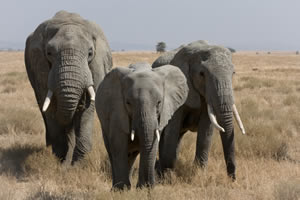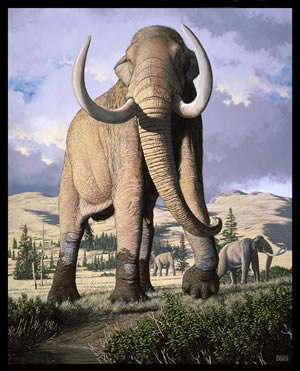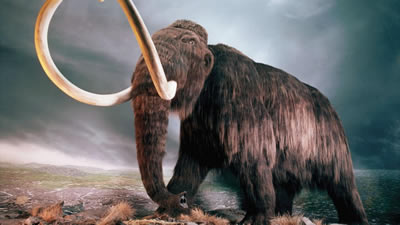Difference between Elephant and Mammoth
Key difference: Elephants are a relative of the Mammoths; both belong to family Elephantidae. In today’s world, mammoths do not exist. It was found that they usually had larger tusks than elephants.
Elephantidae are the only surviving family of the order Proboscidea; the other families of the order, which included mammoths and mastodons, went extinct.

The word “elephant” is based on the Latin elephas (genitive elephantis) (“elephant”), which was the Latinised form of the Greek ‘elephas’ (genitive elephantos). Over 161 extinct members and three major evolutionary radiations of the order Proboscidea have been recorded.
The classification of elephants is:
Scientific name: Elephantidae
Rank: Family
Lifespan: 60 years on average
Mass: 5,500 kg on average
Height: 330 cm on average
Elephants belong to the family Elephantidae, the only remaining family within the order Proboscidea. Sirenians (Dugongs and Manatees) and the Hyraxes are their closest extant relatives with which they share the clade Paenungulata within the superorder Afrotheria.
Traditionally, two species of elephants are recognised; the African elephant (Loxodonta africana) of sub-Saharan Africa, and the Asian elephant (Elephas maximus) of South and Southeast Asia. The International Union for Conservation of Nature (IUCN) has considered the African elephants as vulnerable, while the Asian elephants have been classed as endangered.
- In 1797, German naturalist Johann Friedrich Blumenbach named the African elephant as Elephas africana. Georges Cuvier in 1825 commonly named the genus Loxodonta. It is found that there are 18 subspecies of the African elephants. The African elephants stand 3–4 m (10–13 ft) and weigh 4,000–7,000 kg (8,800–15,000 lb).
- In 1758, Swedish zoologist Carl Linnaeus described the genus Elephas by describing a Sri Lankan elephant; under the binomial Elephas maximus. Georges Cuvier in 1798 then classified the Indian elephant under the binomial Elephas indicus. Asian elephants vary geographically in their color and amount of depigmentation. One of the research-cist observed and classified the Asian elephants into 3 subspecies. The Asian elephants stand 2–3.5 m (7–11 ft) and weigh 3,000–5,000 kg (6,600–11,000 lb).
 An elephant's skull is resilient enough to withstand the forces generated by the leverage of the tusks and head-to-head collisions. They have thick ear bases with thin tips. The trunk, or proboscis, is a fusion of the nose and upper lip. In the early fetal life, the upper lip and trunk are separated. The trunk elongates and is a specialized organ which makes elephant the most important and versatile appendage. It contains up to 150,000 separate muscle fascicles, with no bone and little fat. The paired muscles of the trunk consist of two major types: superficial (surface) and internal. The trunk performs multiple functions, which include, breathing, touching, grasping, sound production and olfaction. Usually, elephants have 26 teeth, the incisors, known as the tusks, 12 deciduous premolars, and 12 molars. The tusks of an elephant are modified incisors in the upper jaw. They replace the deciduous milk teeth when they reach 6–12 months of age and grow continuously at about 17 cm (7 in) within a year. A newly developed tusk has a smooth enamel cap that eventually wears off. The dentine is known as ivory and its cross-section consists of crisscrossing line patterns which is known as "engine turning", which create diamond-shaped areas. The elephant’s skin is generally very tough, at 2.5 cm (1 in) thick on the back and parts of the head. The brain of an elephant weighs 4.5–5.5 kg (10–12 lb), which is smaller in proportion. Its heart weighs 12–21 kg (26–46 lb) and has a double-pointed apex, which is an unusual trait among mammals. Elephants are polygynous breeders and their copulations frequently take place during the peak of wet season. The Gestation phase in elephants lasts typically around two years with the inter-birth intervals lasting for four to five years.
An elephant's skull is resilient enough to withstand the forces generated by the leverage of the tusks and head-to-head collisions. They have thick ear bases with thin tips. The trunk, or proboscis, is a fusion of the nose and upper lip. In the early fetal life, the upper lip and trunk are separated. The trunk elongates and is a specialized organ which makes elephant the most important and versatile appendage. It contains up to 150,000 separate muscle fascicles, with no bone and little fat. The paired muscles of the trunk consist of two major types: superficial (surface) and internal. The trunk performs multiple functions, which include, breathing, touching, grasping, sound production and olfaction. Usually, elephants have 26 teeth, the incisors, known as the tusks, 12 deciduous premolars, and 12 molars. The tusks of an elephant are modified incisors in the upper jaw. They replace the deciduous milk teeth when they reach 6–12 months of age and grow continuously at about 17 cm (7 in) within a year. A newly developed tusk has a smooth enamel cap that eventually wears off. The dentine is known as ivory and its cross-section consists of crisscrossing line patterns which is known as "engine turning", which create diamond-shaped areas. The elephant’s skin is generally very tough, at 2.5 cm (1 in) thick on the back and parts of the head. The brain of an elephant weighs 4.5–5.5 kg (10–12 lb), which is smaller in proportion. Its heart weighs 12–21 kg (26–46 lb) and has a double-pointed apex, which is an unusual trait among mammals. Elephants are polygynous breeders and their copulations frequently take place during the peak of wet season. The Gestation phase in elephants lasts typically around two years with the inter-birth intervals lasting for four to five years.
Elephant is the largest living terrestrial animal. They are herbivorous in nature, and are found in different habitats, including the savannahs, forests, deserts and marshes and prefer to stay in water most of the time. They are mammals and are considered to be the keystone species due to their impact on their environments. They live in a socialized family, as groups, which are formed due to the fission-fusion society bonds. They basically communicate by touch, sight, smell and sound; and use the infrasound and seismic communication for longer distances. Elephants are known for their intelligence, and have been compared with primates and cetaceans. They have the capability of self-awareness. They also show empathy for dying or dead individuals of their kind.
There is a threat of extinction for elephants in today’s world because they have been used for various purposes. They have been killed by the humans for their greedy uses and needs. Elephants are considered as a working animal, as they have the capacity to carry heavy loads for a longer distance. There are organizations working to save this animal, so its people’s responsibility to help those organizations, as elephants play a vital role in the maintenance of ecological balance on the earth.

The word ‘mammoth’ was first used in Europe during the early 1600s, referring to maimanto tusks discovered in Siberia.
The classification of Mammoth is:
Scientific name: Mammuthus
Higher classification: Elephantidae
Rank: Genus
Lower classifications: Mammuthus meridionalis
The Elephantidae family existed around six million years ago in Africa. These included the living elephants and the mammoths. The Mastodon, an extinct clad, is the only distant relative of the mammoths, and is also a part of the separate Mammutidae family, which diverged 25 million years before the mammoths evolved.
The earliest known types are named as M. rumanus, which were found in Europe and China. The first known members of the genus Mammuthus are the African species M. subplanifrons from the Pliocene and M. africanavus from the Pleistocene. Around 1 million years ago, M. trogontherii, evolved in East Asia. Afterwards, they migrated to Siberia and became the woolly mammoth, M. primigenius. The Columbian mammoth, M. columbi, also evolved from a population of M. trogontherii and afterwards migrated to North America. Due to the difference in the physical appearance, the European mammoths are separately distinguished into clusters:
- Early Pleistocene Mammuthus meridionalis
- Middle Pleistocene Mammuthus trogontherii
- Late Pleistocene Mammuthus primigenius
 Mammoths are elephant-like animals, which lived 58 million years ago. They are medium to large-sized elephants. Mammoths seen from the side are highest at the shoulders, sloping rearward with a slightly humped profile. They had thick and dense layer of fur coats on their bodies for the protection from the cold temperatures of North America during the Ice Age. They had bumps on their head. They had shallow-rooted teeth, called hyspodants, which were tall and helped them to grind the grass. Mammoth tusks weighed over 150 pounds and were long (16 feet). The tusks curved towards their face. Some tusks were also straight. Most of the mammoth’s physical characteristics resemble the elephants. The diet of the mammoths differed, depending upon their species and race. The Columbian mammoth’s (M. columbi) diet was mainly of a grazer; the American Columbian mammoths fed primarily on cacti leaves, trees, and shrubs; the Mongochen mammoth’s diet consisted of herbs, grasses, larch, shrubs, and possibly alder; and the European mammoths had a major diet of C3 carbon fixation plants.
Mammoths are elephant-like animals, which lived 58 million years ago. They are medium to large-sized elephants. Mammoths seen from the side are highest at the shoulders, sloping rearward with a slightly humped profile. They had thick and dense layer of fur coats on their bodies for the protection from the cold temperatures of North America during the Ice Age. They had bumps on their head. They had shallow-rooted teeth, called hyspodants, which were tall and helped them to grind the grass. Mammoth tusks weighed over 150 pounds and were long (16 feet). The tusks curved towards their face. Some tusks were also straight. Most of the mammoth’s physical characteristics resemble the elephants. The diet of the mammoths differed, depending upon their species and race. The Columbian mammoth’s (M. columbi) diet was mainly of a grazer; the American Columbian mammoths fed primarily on cacti leaves, trees, and shrubs; the Mongochen mammoth’s diet consisted of herbs, grasses, larch, shrubs, and possibly alder; and the European mammoths had a major diet of C3 carbon fixation plants.
Today, the mammoth species do not exist; the last mammoths was found around some 4,000 years ago. Some of the reasons responsible for the extinction of the mammoths were: the warming trend (Holocene) that occurred over the 12,000 years ago, accompanied with the glacial retreat and rising sea levels; the forests got replaced by open woodlands and grasslands across the continents; the spread of human hunters through northern Eurasia and Americas with new developed tools; and the changes in the climatic conditions and rise of Ice-age due to the less mega-faunal production.
Comparison between Elephant and Mammoth:
|
|
Elephant |
Mammoth |
|
Description |
Elephants are large mammals of the family Elephantidae and the order Proboscidea. |
Mammoth is any species of the extinct genus Mammuthus and belong to the Elephantidae family. |
|
Relation |
Elephants were relatives of the Mammoths. |
Mammoths existed around some 2 million years ago. |
|
Skin |
They have less hair on their skin. |
They had thick hair and some also had a thick layer of dense fur on their skin. |
|
Tusks |
The elephants have short tusks compared to the mammoths. |
Mammoths had long and straight long tusks. |
|
Types |
The types of elephants in today’s era are:
|
Types of Mammoths are:
|
|
Existence |
They are still in existence, but are an endangered species. |
They are extinct; they are no more in existence. Some of their species are found, but only in the museums. |
Image Courtesy: wikimedia.org, westfield.ma.edu, travisbeacham.tumblr.com, hdwallpapercorner.com









Add new comment